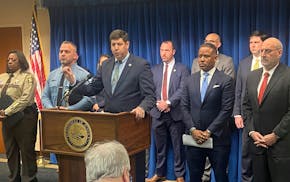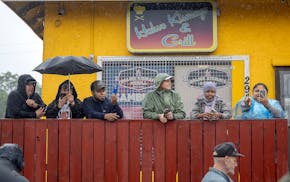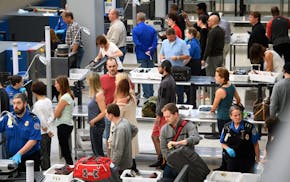MORRIS, Minn. – Jade Michaelson moved to this west-central Minnesota town a year ago when her husband bought an auto-repair shop in Morris. Immediately, she confronted two problems. One was employment: How could a preschool teacher find work in a county with one child-care center? The other was finding child care for her two young kids. She certainly didn't want to open her home to in-home child-care chaos.
Like anywhere in greater Minnesota, Stevens County, home to University of Minnesota Morris and three major dairies, has a long, stubborn child-care problem. The problem has only deepened in recent years. A decade ago, the county had 34 child-care providers. When Michaelson arrived, there were 15 — the center plus 14 in-home providers — meaning the county of 10,000 people had lost 220 child-care spots in 10 years.
But just as Michaelson's family moved to town, Stevens County launched an ambitious experiment in solving its rural child-care crisis. It was Michaelson's perfect solution: an in-home child care outside of her home.
The county took $1.28 million of its $2 million in federal COVID relief money to build six child-care "pods" — a nearly 6,000-square-foot building of six rowhouses with capacity for 84 child-care spots. The long, thin houses look like suburban starter homes, with spacious living rooms serving as play areas and learning centers.
"The space we have is perfect," she said on a recent morning, holding a crying toddler who just stubbed her toe. "If this wasn't here, I wouldn't have started a day care. No way."
The county also, with the help of a Minnesota Department of Economic Development grant, doubled the size its one child-care center, from 42 spots to 84.
The child-care problem is a vexing issue in both rural and urban areas across the state. A Duluth task force this month termed it a "near-crisis" in Minnesota's fourth-largest city, where four child-care centers closed last year and three more this year. The report said the city has about 3,000 child-care slots — but 4,200 kids age 6 or younger with parents who are part of the workforce.
Minnesota lawmakers have discussed a child-care affordability scholarship program.
But the problem is most acute in rural Minnesota, particularly in the northern and central parts of the state. A 2022 report by the Center for Rural Policy and Development put it this way: "The lower the population density of a region, the lower its ability to sustain child-care centers."
It's not just a major annoyance for young families; it's a major inhibitor of rural economic growth, said Ben Winchester, a rural sociologist for University of Minnesota Extension. Companies in rural Minnesota are adding jobs but struggling to find employees because of shortages in housing and child care.
Rural job vacancy rates have increased since the Great Recession, and a 2021 report cited child care as the single biggest thing economically holding back rural Minnesota. Studies show greater Minnesota has half the child-care capacity it had in 2000. It's mostly a money equation: In-home child care doesn't pay well, and rural areas can't sustain many larger centers.
"There's a gap between what parents can afford and what providers need to be paid," said Marnie Werner, vice president of research and operations for the Center for Rural Policy and Development. "People are looking for magic bullets. Some people think government needs to step in and take over the whole thing."
Federal statistics show median wages for child-care workers are on par with those of cashiers or hotel clerks.
Nationally, more than two-thirds of children have all parents in the workforce, but a lack of affordable care forces families to cut back on work hours, avoid demanding promotions or leave the workforce, according to a study by the Center for American Progress. The study also showed half of American children under 5 lived in a child-care desert, a problem exacerbated by the pandemic. Experts link child-care access directly to economic development and community vitality.
"It's a broken business model no matter where you go," said Jessica Beyer, associate Minnesota director for First Children's Finance, a national nonprofit focused on the business side of child care which gave a grant to the Morris project. "It comes back to ratios and staffing. There's as much of a need in the Twin Cities metro as in rural Minnesota, but the solutions are going to look very different."
First Children's Finance will highlight Morris' pods and other innovative child-care solutions across greater Minnesota in its conference this week in Hutchinson. Among the innovative child-care solutions highlighted at the conference: the southwest Minnesota town of Hills, which developed an empty storefront into a child care; Warren in northwest Minnesota, the first Minnesota city to fund a child care with a local sales tax; Luverne in southwest Minnesota, which is building a larger-than-needed child-care center to attract an employment base.
Urban areas tend to have more child-care centers, which need a certain volume of kids to stay profitable, while rural child care is predominantly in-home. Larger child-care centers simply aren't viable outside large metro areas. A complaint often heard among rural child-care providers in Minnesota is that lawmakers tend to go with one-size-fits-all regulations that make more sense in urban areas than in rural.
The pod model has been used other places around the state, such as in Little Falls, where the hospital recently started leasing a building for child-care pods, or in Detroit Lakes, which began the state's first pod model a couple of decades ago in partnership with Head Start.
The desirability of the pod model is that it offers some of the scale of a large child-care center while being regulated like smaller in-home child care. The Morris model is unique because it's county-owned and because of the townhouse format, where each provider has a separate home to run a child care from.
One thing that may make it difficult to replicate: The seed money came from the county's rare windfall of federal COVID relief money.
The idea for the Stevens County pods started with county Commissioner Jeanne Ennen, who ran an in-home child care when her kids were little. Ennen heard about a small pod model in Becker County in a duplex, and area farmers who did similar things on ancillary structures on their farm.
"What if we could co-locate a bunch of these, remove the barriers for construction?" wondered county Administrator Rebecca Young. The county debated putting the money toward a new child-care center vs. this pod model, but officials determined the pod model would have less red tape and cost less.
Five of the six child-care providers who started in the first pods a year ago were first-time providers.
"We really focused on how can we help you make a successful business that you're going to be in long term," Young said. "We tried to look at all the barriers to day care. They all said if it wouldn't have been for this model, they wouldn't have started a day care."
One barrier this model hasn't solved is how child-care providers can get health insurance. A 2020 survey of recently closed family child-care providers by the Minnesota Department of Management and Budget cited a lack of benefits as their top reason for closing. State and federal legislators, including Sen. Amy Klobuchar and Rep. Michelle Fischbach, have visited the Stevens County pods, and Ennen has floated the idea of a statewide pool of child-care providers to get insurance-purchasing power.
On the recent morning in Morris, Michaelson pulled a sugar-free Red Bull from her stash in the refrigerator and opened the back door. A couple of kids followed her outside. She pointed out a small frog on the side of the building. "It's a tree frog, no way!" a 4-year-old shouted. The kids talked about their favorite toys: the dinosaur game, the cars in the yard, the swing set.
There are six potential providers on a waiting list for the Stevens County pods. Anticipating expansion, the county ran sewer infrastructure beneath the parking lot; there's space for as many as 16 more pods to be built.
"Now that we have a model, it's a lot easier to go to private investors and say, 'This works. Fund this model,'" said Young, the county administrator.
The bookmobile stops here. Unlike in-home child cares, there's no outside influences: no pets, no other family members.
Running an in-home child care can be isolating, but this model comes with a support network of other providers nearby. They'll often walk the kids to the park or splash pad together. The provider next door has become Michaelson's best friend.
"Nobody else really understands," Michaelson said. "I worried about that going into this. And then being able to just go home afterwards, that's huge."

Walz: State had no advance notice of federal raid in Minneapolis

Five members of Minneapolis Highs street gang found guilty of racketeering conspiracy

Midea recalling 1.7 million of its popular air conditioners due to mold concern

Social media, text chains helped anti-ICE protesters get the word out during Minneapolis raid

